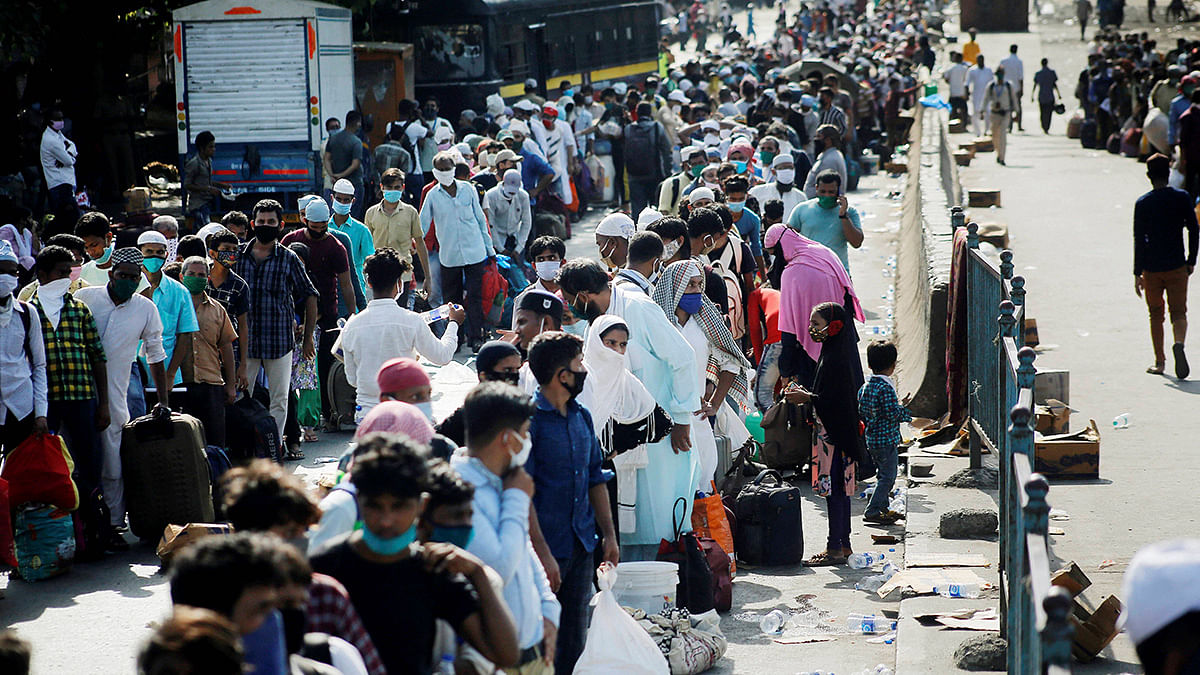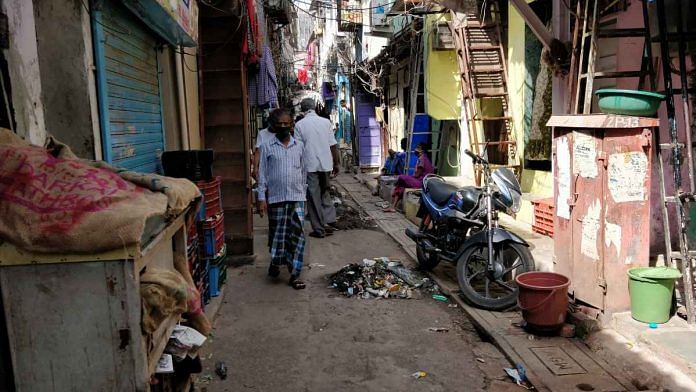Mumbai: Mumbai’s Dharavi, known as Asia’s largest slum, recorded its first coronavirus case on 1 April, sparking fears of a large hotspot in the city. As it stands, India’s financial capital currently has the highest number of active cases in the country.
Fast forward two months, the virus curve in Dharavi, part of Mumbai’s G North administrative ward, appears to be flattening.
In contrast, a few municipal wards of Mumbai’s northern suburbs that had very few cases initially, are now recording a spike of nearly 5 per cent every day.
So what helped turn Dharavi’s story around?
A series of innovative experiments — bringing in private practitioners, isolating vulnerable populations, getting large quarantine facilities and taking over private hospitals for treatment — seemed to have done the trick.
Also read: Maharashtra has highest number of Covid cases in India, but is fifth in terms of fatalities
Dharavi’s case timeline
As of 12 June, Dharavi recorded 2,013 coronavirus cases, but its daily growth rate was 1.57 per cent as against the city’s 3 per cent and the 5 per cent in other wards such as P North, R South and S wards (all of these comprise Mumbai’s north-western regions).
There were no deaths recorded between 30 May and 8 June but six deaths have been reported in the last four days, taking the toll to 77.
Overall, Mumbai has recorded 55,451 Covid-19 positive cases, almost a fifth of the total cases in the country. Of these, 28,248 were active as of Saturday.
Also read: Dharavi is a ticking bomb in the Covid-19 challenge, nothing being rolled out will be enough
Turning things around
Dharavi is home to about 8.5 lakh people, all living in very close, cramped quarters within a 2.5 square kilometre area.
On 11 June, it recorded just 20 new cases. The doubling rate — the time in which the current total number of cases double — for the slum touched 44 days, much higher than the city’s average of about 22 days.
“It was a task that was deemed to fail but we have surprised everyone,” said Kiran Dighavkar, assistant municipal commissioner, in charge of G north ward consisting of Dadar, Mahim and Dharavi.
Social distancing and lockdown — the twin strategies that are largely regarded as the only effective ways to counter coronavirus in the absence of treatment or a vaccine — do not work in Dharavi.
With houses just 10×12 feet, providing shelter to large families of seven to eight members, transmission through the community was inevitable. So instead, municipal authorities carried out rigorous contact tracing, testing and quarantining of coronavirus cases as well as cleaning community toilets to maintain hygiene since most of the slum residents depend on them.
“We are reaping the benefits of the absolute rigorous contact tracing done in the initial days,” said Dr Rama Shyam, programme director of adolescent programme at SNEHA, a non-profit that works in Dharavi.
The Brihanmumbai Municipal Corporation’s (BMC) helpline (1916) had been very responsive in dealing with queries and giving out information, she added.
Dighavkar said the BMC has conducted around 7,000 tests in Dharavi till date, with an additional 2,000 tests being done by the private labs.
Dr Shyam further said with lockdown being lifted and people starting to crowd streets and markets, clear data-driven communication about preventive steps and civic body’s preparedness is needed to keep the cases numbers low.
What has also helped Dharavi’s case is the mass exodus of migrant workers. About 1.5 lakh who live in Dharavi left the city and returned to their native homes, according to BMC officials.

Meanwhile, with cases falling, municipal schools that were converted into quarantine centres are being handed back to school administrations so they can be ready whenever the government allows students to return.
“This will help regain people’s confidence,” said Dighavkar.
Finding more doctors to screen Dharavi
To screen each of the households in Dharavi was nearly impossible. BMC staff in personal protection equipment (PPE) carried out the screening, often fainting due to the heat trapped in the narrow alleys.
After the initial 47,000 who were screened door-to-door, the strategy changed. People with symptoms were asked to come for screenings and nine BMC dispensaries and 350 private practitioners were roped in along with fever camps to carry out this exercise.
In one such clinic, private practitioner Dr Anil Pachnekar’s clinic on 90 feet Road in Dharavi, ThePrint saw a long queue of patients waiting outside.
Irrespective of their symptoms, all patients were screened for fever and their oxygen saturation levels were checked. The familiarity with local practitioners meant residents were more forthcoming about their health, said Pachnekar.
Using this strategy, local authorities were able to screen 3.6 lakh people apart from another 1.2 lakh senior citizens, who are more vulnerable to the infection.
Since patients were screened and quarantined early, they were monitored, thus avoiding a drastic rise in the mortality rate due to late admissions, said Dighavkar.
Also read: Why bureaucratic control over Covid-19 testing is counterproductive as India ‘unlocks’
Large quarantine centres to the rescue
While contact-tracing was one measure, setting up large quarantine centres was the complementary factor.
The first large facility that the administration took over in Dharavi was the Rajiv Gandhi Sports Complex with 300 beds. Soon, municipal schools as well Mahim Nature Park were taken over as isolation and quarantine facilities with a capacity of 3,800.
Until June more than 8,500 were quarantined in such facilities.
Apart from 24-hour monitoring and care, some centres provided more holistic and innovative care. For instance, everyday at the Rajiv Gandhi Sports Complex, patients with coronavirus symptoms and those who were asymptomatic were put through aerobics, yoga and breathing exercises. The sessions had a twin purpose — to keep patients active and help them relax.
“Most of the patients in the centre had no symptoms, but dealing with the stress of being diagnosed with Covid-19, they panicked and their health deteriorated,” said Dr Dhananjay More, a private practitioner who was appointed as an emergency medical officer at the Rajiv Gandhi Sports Complex on 20 April.
He came up with the idea of holding yoga and pranayam sessions. Such sessions can help the asymptomatic to recover and not require hospitalisation, he said. From 100-200 people in May, his facility now has only 45 patients.
For providing critical care, the BMC took over five private hospitals in the area.
“We did not wait for the cases to reach 100 to start acting. The first fever clinic was started three days after the first case; we took over the 200-bedded Sai Hospital to treat serious cases within the first two weeks,” Dighavkar said. This ensured patients didn’t have to search in Mumbai’s crowded public hospitals for beds.
Also read: Mumbai works to ramp up its health infra as it slowly surfaces from Covid lockdown
Challenges continue
Dharavi has certainly surfaced from what was a potentially really bad case of coronavirus. But there are still issues.
During the lockdown, the municipal corporation sent dry rations to 24,000 families and fed 19,000 people, including 11,000 iftar meals.
However, this was not enough considering the huge population, the fact that most residents were now jobless after the lockdown, and ration shops were only giving out rice and wheat. Instead, it was non-profit and volunteer groups who stepped in and provided dry ration kits and thousands of cooked meals.
Dighavkar said the national media spotlight on Dharavi also helped ensure donations.
However, this avenue is fast drying up.
“The donations are drying up but we are still getting 100-200 calls for food supplies requests everyday,” said Shaheem Shaikh, a volunteer who mans the 24X7 lockdown helpline. Shaikh has been part of the relief work since March, and has given out ration kits to over 900 families in Dharavi.
Some have alleged that hospitals dealing with non-Covid cases were not functioning properly. Raju Korde of Dharavi Bachao Andolan, said, “My friend’s father expired because he didn’t get dialysis for 12 days … the technician at the hospital where he went to did not turn up and other hospitals refused treatment without a Covid test.”
However, Dighavkar refuted the claim that regular health facilities weren’t up and runnung, and said the BMC was running five hospitals in the area, of which, only one was a Covid-designated hospital.
Then there is the challenge of a possible second wave as migrants slowly return, as well the threat of more diseases when the monsoon arrives. Low-lying areas like Dharavi are especially prone to monsoon-related problems, beginning with flooding.
Dighavkar said they are prepared for any eventuality.
“There is a 1,000 bed quarantine facility at Mahim Nature park as well as 200 bed hospital in front of it, with oxygen supply … so if the cases increase, we have our resources ready.”
Also read: Dharavi is not just fighting coronavirus, but also dirty toilets and battered image




Hello Swagat, I have heard that the THE GOVERNMENT HAS GIVEN STRICT INSTRUCTIONS THAT IN DHARAVI THEY DONT HAVE TO SHOW A NUMBER OF MORE THAN 130 IN A WEEK.
PLease check on this .
Fantastic work. A model for the world especially Brazil. Better than kerala model.
Dear Vijay
I thought they have worked on metal model ..with the team from.ketal helping them..
..Acknowledging people who helped is basic courtesy…
trivial..
the result of extreme inequalities, concentration of wealth n wealthy.. the heaps of garbage they created n reduced countless population to becoming insects living out of those heaps.. to help d rich n greedy to continue to be parasites..
we, as a country are shameless.. neither we care to remove inequalities.. nor we care to improve the marginalized..
we can’t even hide our shameless heads.. but we allow the establishment to score a point over these dire conditions.
we have no shame to mention that nearly a hundred people share a toilet.. after more than seven decades of independence and 7 years of swachh bharat.. the citizens in the commercial capital of the country have this fate.. but we are utterly shameless to gloat that they all didn’t die of covid. We deserve to die only of utter shame n nth else.
the virus in the country is spreading freely without any checks.. this is not a time to create n spread opinions about establishment.. it is time to think of our everlasting problems worsening since our births..
over population, urban migration, urban poverty, lack of rural industry, lack of infra in rural India, neglect of agriculture, corrupt establishment n banking.. corrupt police, lack of law n order.. slow judiciary.. decades of ignorance.. crazy run behind English.. lack of basic education, ignoring knowledge taught by elders from light years.. there is no end to what we should be spending our time on..
reducing cases in worst slum we created, is not a story worth a milli-second of National time.